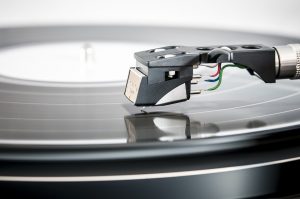
To cope with internet overload, we allow algorithms to sift through and feed us bits and pieces to match our tastes or cosmetically enhanced anchormen (and anchorwomen) to spoon up headlines to the tune of tone-deaf sponsors. How does this affect the arts… and more specifically music?
Analog vs Digital Music
As technology moved vinyl to tape to CD, the ‘album’ remained, but underwent significant changes, including a subliminal one. When listening to a vinyl album or taped music, you’re actually listening to ‘analog’ sound waves being produced. With a CD, the sound waves are ‘digitized’ or broken up into pieces that your brain then puts together, much like looking at a bunch of colored dots up close, then standing back until you discover they make a picture. Perhaps this explains why I can’t sit and listen to a CD like I once did a vinyl album.
Napster, the beginning of the end…
When record companies began suing their own customers for peer-to-peer downloading, the graffiti was on the wall. Like the industrial revolution before, the digital age wiped out the multi-billion dollar record business we once thought recession proof and timeless. But the music didn’t die, it simply morphed into another dimension as the infrastructure built to filter, foster, package, market and sell it disappeared. Now music exists in an unfiltered internet ocean requiring navigational tools like Spotify and Pandora. And the vestiges of past record companies, co-opted into entertainment conglomerates, now create brands instead of artists, with commercials, soundtracks, and albums produced, not for the music, but to sell the brand.
So, what’s next?
In the ‘80s, with the bestseller “Megatrends,” author John Naisbitt theorized that in a world of high tech, people would begin to long for personal, human contact. And at a recent music business convention, I couldn’t help but notice everyone so intent on their mobile phones, no one made eye contact. (No wonder “The Walking Dead” is so popular on TV). Could there be a reaction to this high tech alienation? A few trends indicate maybe so.
First, the amazing increase in vinyl record sales. And it’s not just to Baby Boomers… Last year Millennials pushed vinyl sales to a 26 year high. And secondly, last year sales figures for acoustic guitars increased for the 5th consecutive year.
This is not to suggest that soon mobile devices will be discarded by new generation of hippies. But we may well see a push-back against corporate branding to more organically grown artists. And don’t be surprised at a proliferation of small local venues where musicians gather to perform and where the audience actually turns off their phones… And if one pops up in my neighborhood, you can bet I’ll be sitting in the front row… or maybe up there playing my Martin D28.
